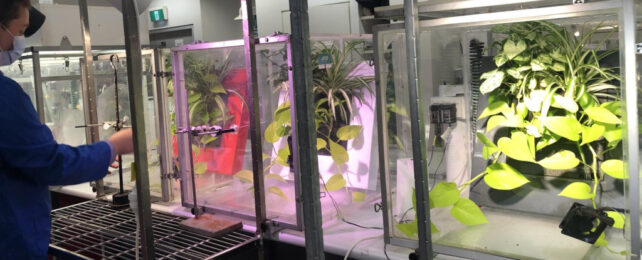Bringing your garden indoors and growing the right plants on your office wall (along with some sophisticated tech) could scrub the air of several common toxic pollutants, new research suggests.
The findings come from scientists at the University of Technology Sydney (UTS) in Australia, who investigated whether a vertical wall system fitted with indoor plants could mop up a mix of harmful compounds found in petrol vapors.
Ultimately, throughout a typical workday, the plants reduced the levels of some notorious cancer-causing compounds to below 20 percent of starting concentrations.
The research was funded by plant-scaping company Ambius, which enlisted the help of the UTS team. A collection of indoor plants mimicking Ambius' small vertical plant wall system were contained in sealed chambers for the experiments.
Although the lab set-up doesn't come close to the size of public spaces, the idea is that installing vertical gardens could help improve indoor air quality by supplementing energy-intensive ventilation systems that flush stale air out of office buildings, hospitals, and classrooms.
It's worth noting that the new findings have not been peer-reviewed, but past research has shown the potential of indoor plants to soak up gaseous compounds, often referred to as volatile organic compounds or VOCs.
However, studies of plant 'purifiers' have typically assessed the removal of single chemical species – not complex mixtures – under controlled conditions and at levels not comparable to real-world exposures.
While this new study similarly used sealed chambers, it pitted common household plants – Devil's ivy (Epipremnum aureum), Arrowhead plants (Syngonium podophyllum), and Spider plants (Chlorophytum comosum) –against petrol vapors, a significant source of mixed VOCs.
"Not only can plants remove the majority of pollutants from the air in a matter of hours," says UTS environmental scientist Fraser Torpy, "they remove the most harmful petrol-related pollutants from the air most efficiently."
Torpy and team tested the Ambius vertical plant wall system using nine purpose-built perspex boxes containing four plants or none at all. A small volume of petrol was vaporized inside the chambers, and researchers measured the gas levels.
Based on a slight reduction of gases in the control chamber, a leak in each of the test boxes couldn't be ruled out. Still, the researchers are confident the plants removed about 43 percent of total VOCs in the 8-hour test period and almost all of three particularly harmful chemical classes: alkanes (98 percent removed), benzene derivatives (86 percent), and cyclopentanes (88 percent).
Removing these airborne contaminants, which can cause "notable health effects," could have "significant effects on the maintenance of a healthy indoor environment," the research team writes in their report.
Benzene compounds are highly carcinogenic and can waft into schools and buildings hundreds of meters away from gas stations and rise above safe levels. Researchers have also long been aware that people who live near gas stations are more likely to develop cancers, such as leukemia.
Parking garages attached to office buildings and homes are another concern for indoor pollution, Torpy and colleagues note.
With more research, vertical gardens may be able to help. "We also found that the more concentrated the toxins in the air, the faster and more effective the plants became at removing the toxins, showing that plants adapt to the conditions they're growing in," says Torpy.
Bear in mind that these vertical greening systems, which often feature a considerable number of potted plants rigged up to air pumps, are a whole step up from our handful of beloved indoor plants sitting on our kitchen shelf. You'd need thousands to make the air inside your home cleaner.
On their own, a humble collection of plants can't clean the air faster enough to affect air quality, researchers say. But they can boost mood.
The experimental set-up of air-tight boxes also harks back to the first NASA studies that likewise monitored plants in sealed chambers – which, of course, is very different from the indoor environment of a big office building with its ventilation systems pumping.
That said, commercial interest in green wall technologies will likely grow off the back of the pandemic, which highlighted the importance of indoor air quality on a global scale.
Torpy and his co-authors – writing this time in a peer-reviewed journal – point out that more research testing large commercial systems in various buildings is needed. Only then can we fully understand if plants can act as air purifiers, with any benefit over and above current ventilation systems.
This includes looking at the type of plants and air filters used, the long-term effects of pollutants on soil microbes, and whether plants reach a saturation point.
Seeing whether plants clear the air of chemicals off-gassed from synthetic materials – the kind of compounds that give your car its new-car smell – is another avenue the researchers are keen to pursue because the current study didn't measure this.
The UTS report is available online.
